| Listing 1 - 10 of 11 | << page >> |
Sort by
|
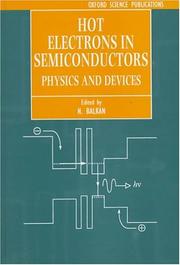
ISBN: 0198500580 Year: 1998 Publisher: Oxford Clarendon Press
Abstract | Keywords | Export | Availability | Bookmark
 Loading...
Loading...Choose an application
- Reference Manager
- EndNote
- RefWorks (Direct export to RefWorks)
Hot carriers --- Quantum electronics --- Semiconductors --- Crystalline semiconductors --- Semi-conductors --- Semiconducting materials --- Semiconductor devices --- Crystals --- Electrical engineering --- Electronics --- Solid state electronics --- Quantum electrodynamics --- Carriers, Hot --- Hot carrier conduction --- Hot electrons --- Electrons --- Holes (Electron deficiencies) --- Materials --- Electronics and optics of solids
Periodical
Abstract | Keywords | Export | Availability | Bookmark
 Loading...
Loading...Choose an application
- Reference Manager
- EndNote
- RefWorks (Direct export to RefWorks)
Plasma (Ionized gases) --- Ions --- Plasma (Gaz ionisés) --- Ions. --- Périodiques. --- Gaseous discharge --- Gaseous plasma --- Magnetoplasma --- Ionized gases --- Intermediates (Chemistry) --- Matter --- Physics --- Solution (Chemistry) --- Electrolysis --- Electrons --- Properties --- Periodicals.
Book
Year: 1998 Publisher: Piscataway, New Jersey : [Piscataqay, New Jersey] : Wiley-IEEE, IEEE Xplore,
Abstract | Keywords | Export | Availability | Bookmark
 Loading...
Loading...Choose an application
- Reference Manager
- EndNote
- RefWorks (Direct export to RefWorks)
Employed in a large number of commercial electromagnetic simulation packages, the finite element method is one of the most popular and well-established numerical techniques in engineering. This book covers the theory, development, implementation, and application of the finite element method and its hybrid versions to electromagnetics. FINITE ELEMENT METHOD FOR ELECTROMAGNETICS begins with a step-by-step textbook presentation of the finite method and its variations then goes on to provide up-to-date coverage of three dimensional formulations and modern applications to open and closed domain problems. Worked out examples are included to aid the reader with the fine features of the method and the implementation of its hybridization with other techniques for a robust simulation of large scale radiation and scattering. The crucial treatment of local boundary conditions is carefully worked out in several stages in the book. Sponsored by: IEEE Antennas and Propagation Society.
Finite element method. --- Electromagnetism. --- Engineering mathematics. --- Electromagnetic fields --- Finite element method --- Antennas (Electronics) --- Microwave circuits --- Electrons --- Electrical & Computer Engineering --- Engineering & Applied Sciences --- Electrical Engineering --- Mathematical models --- Scattering
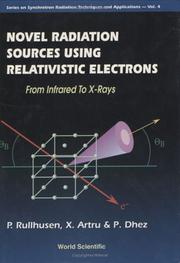
ISBN: 9810230508 9789810230500 Year: 1998 Publisher: Singapore World scientific
Abstract | Keywords | Export | Availability | Bookmark
 Loading...
Loading...Choose an application
- Reference Manager
- EndNote
- RefWorks (Direct export to RefWorks)
Electrons. --- Radiation sources. --- X-rays. --- Electrons --- Radiation sources --- X-rays --- 535.374 --- Rays, Roentgen --- Roentgen rays --- Roentgenograms --- Electromagnetic waves --- Ionizing radiation --- Radiation --- Cathode rays --- Radiography --- Vacuum-tubes --- Sources of radiation --- Quantum optics --- Corpuscular theory of matter --- Atoms --- Leptons (Nuclear physics) --- Matter --- Particles (Nuclear physics) --- Ions --- Positrons --- 535.374 Amplification of radiation by stimulated emission --- Amplification of radiation by stimulated emission --- Constitution
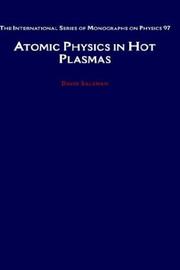
ISBN: 1280529148 9786610529148 0195355156 1429400153 0195109309 9780195109306 9781429400152 9780195355154 9789812794796 9812794794 9781280529146 6610529140 0197732062 Year: 1998 Publisher: New York Oxford University Press
Abstract | Keywords | Export | Availability | Bookmark
 Loading...
Loading...Choose an application
- Reference Manager
- EndNote
- RefWorks (Direct export to RefWorks)
The aim of this text is to provide the reader with a coherent and updated comprehensive treatise on the field of atomic physics in hot plasmas, that can be used both for tutorial and professional purposes.
Atoms. --- High temperature plasmas. --- Ions. --- Plasma spectroscopy. --- Plasma (Ionized gases) --- Spectroscopy, Plasma --- Spectrum analysis --- Intermediates (Chemistry) --- Matter --- Physics --- Solution (Chemistry) --- Electrolysis --- Electrons --- Hot plasmas --- Plasmas, High temperature --- Gases at high temperatures --- Chemistry, Physical and theoretical --- Stereochemistry --- Spectra --- Properties --- Constitution
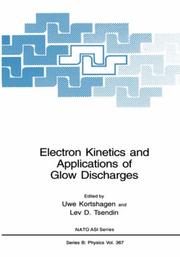
ISBN: 1280206470 9786610206476 0306470764 0306458225 Year: 1998 Volume: 367 Publisher: New York, New York State : Plenum Press,
Abstract | Keywords | Export | Availability | Bookmark
 Loading...
Loading...Choose an application
- Reference Manager
- EndNote
- RefWorks (Direct export to RefWorks)
This book resulted from the NATO Advanced Research Workshop on “Electron Kinetics and Applications of Glow Discharges,” held in St. Petersburg, Russia, on May 19-23, 1997. Glow discharges have found widespread applications in many technological processes from the manufacture of semiconductors, to recent developments in na- technology, to the traditional fields of gas lasers, and discharge lamps. Consequently, the interest in the physics of glow discharges has experienced yet another resurgence of interest. While the non-equilibrium character of glow discharges is widely accepted, the opinion still prevails that the main features can be captured by fluid models, and that kinetic treatments are only required for the understanding of subtle details. The erroneousness of this belief is demonstrated by the failure of fluid models to describe many basic features of glow discharges such as, for instance, electrode phenomena, striations, and collisionless heating effects. An adequate description of glow discharges thus has to be of kinetic nature.
Electrons -- Congresses. --- Glow discharges -- Congresses. --- Glow discharges --- Electrons --- Physics --- Physical Sciences & Mathematics --- Nuclear Physics --- Electricity & Magnetism --- Physics. --- Nuclear physics. --- Heavy ions. --- Hadrons. --- Nuclear Physics, Heavy Ions, Hadrons. --- Congresses --- Ions --- Atomic nuclei --- Atoms, Nuclei of --- Nucleus of the atom --- Corpuscular theory of matter --- Atoms --- Leptons (Nuclear physics) --- Matter --- Particles (Nuclear physics) --- Cathode rays --- Positrons --- Cold cathode discharges --- Discharges, Cold cathode --- Discharges, Gas --- Discharges, Glow --- Gas discharges --- Joshi effect --- Electric discharges --- Electric discharges through gases --- Constitution

ISBN: 0780334256 0198504799 0470544651 9780470544655 9780780334250 Year: 1998 Publisher: New York (N.Y.) Institute of Electrical and Electronics Engineers
Abstract | Keywords | Export | Availability | Bookmark
 Loading...
Loading...Choose an application
- Reference Manager
- EndNote
- RefWorks (Direct export to RefWorks)
Employed in a large number of commercial electromagnetic simulation packages, the finite element method is one of the most popular and well-established numerical techniques in engineering. This book covers the theory, development, implementation, and application of the finite element method and its hybrid versions to electromagnetics. FINITE ELEMENT METHOD FOR ELECTROMAGNETICS begins with a step-by-step textbook presentation of the finite method and its variations then goes on to provide up-to-date coverage of three dimensional formulations and modern applications to open and closed domain problems. Worked out examples are included to aid the reader with the fine features of the method and the implementation of its hybridization with other techniques for a robust simulation of large scale radiation and scattering. The crucial treatment of local boundary conditions is carefully worked out in several stages in the book. Sponsored by: IEEE Antennas and Propagation Society.
Finite element method. --- Electromagnetism. --- Engineering mathematics. --- Electromagnetic fields --- Finite element method --- Antennas (Electronics) --- Microwave circuits --- Electrons --- Electrical & Computer Engineering --- Engineering & Applied Sciences --- Electrical Engineering --- Mathematical models --- Scattering --- Microwave circuits. --- Champs électromagnétiques --- Méthode des éléments finis --- Antennes (Electronique) --- Circuits pour micro-ondes --- Mathematical models. --- Scattering. --- Modèles mathématiques --- Antennas (Electronics). --- 517.96 --- 517.96 Finite differences. Functional and integral equations --- Finite differences. Functional and integral equations --- Circuits, Microwave --- Electronic circuits --- Microwave devices --- FEA (Numerical analysis) --- FEM (Numerical analysis) --- Finite element analysis --- Numerical analysis --- Isogeometric analysis --- Electron-positron scattering --- Electron scattering --- Scattering (Physics) --- Electronic apparatus and appliances --- Electromagnetic fields - Mathematical models. --- Electrons - Scattering.

ISBN: 0124759750 9780124759756 9786611768607 128176860X 0080860206 9780080860206 9781281768605 Year: 1998 Volume: 30 Publisher: San Diego : Academic Press,
Abstract | Keywords | Export | Availability | Bookmark
 Loading...
Loading...Choose an application
- Reference Manager
- EndNote
- RefWorks (Direct export to RefWorks)
This volume introduces the subject of laser ablation and desorption to scientists and engineers. It covers fundamental experimental and theoretical tools, models, and techniques, and introduces the most important applications. Clearly written and organized in a straightforward manner, Laser Ablation and Desorption lead the reader straight through the fundamentals of laser-surface interactions. Each chapter is self-contained and includes references to other chapters as necessary, so that readers may begin with the topic of greatest interest and follow the references to other aspects of t
Ablatie door laser --- Ablation par laser --- Field desorption mass spectrometry --- Laser ablation --- Massa spectroscopie met velddesorptie --- Spectroscopie de masse à désorption de champ --- Laser ablation. --- Electron-stimulated desorption --- Ablation laser (Fabrication) --- Désorption stimulée par électrons --- Electron-stimulated desorption. --- Desorption, Electron-stimulated --- Desorption induced by electron transitions --- Electronic desorption --- Electronically induced desorption --- Adsorption --- Surface chemistry --- Ablation, Laser --- Laser-induced ablation --- Lasers --- Manufacturing processes --- Industrial applications
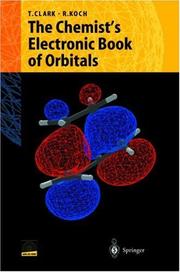
ISBN: 3540637265 3662131501 Year: 1998 Publisher: Berlin : Springer,
Abstract | Keywords | Export | Availability | Bookmark
 Loading...
Loading...Choose an application
- Reference Manager
- EndNote
- RefWorks (Direct export to RefWorks)
This new electronic textbook introduces chemistry students to the world of orbitals using 3D and VRML representation of molecular orbitals. The electronic components of the book are included - together with the necessary representation tools - in the CD-ROM accompanying the book. A short introduction to the basic chemistry and physics of orbitals enables the reader to use the VRML world of orbitals on the CD successfully. The CD itself contains an extended interactive textbook and a broad selection of classical organic compounds and inorganic complex ligands including their orbitals. In several demonstrations, the student may interactively alter relevant parameters and watch the change in the orbitals' characteristics or take a walk through the 3D-VRML representations of the orbitals.
539.18 --- Molecular orbitals --- #WSCH:AAS2 --- Orbitals, Molecular --- Chemical bonds --- Electrons --- Molecules --- Overlap integral --- Quantum chemistry --- Valence (Theoretical chemistry) --- Wave mechanics --- Physics of single atoms --- 539.18 Physics of single atoms --- Molecular orbitals. --- Orbites moléculaires --- Organic chemistry. --- Inorganic chemistry. --- Chemoinformatics. --- Organic Chemistry. --- Inorganic Chemistry. --- Computer Applications in Chemistry. --- Chemical informatics --- Chemiinformatics --- Chemoinformatics --- Chemistry informatics --- Chemistry --- Information science --- Computational chemistry --- Inorganic chemistry --- Inorganic compounds --- Organic chemistry --- Data processing --- Atomic orbital
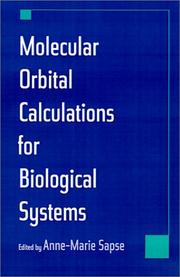
ISBN: 019756089X 1280528222 9786610528226 0195356845 1429404264 9781429404266 9780195098730 0195098730 Year: 1998 Publisher: New York : Oxford University Press,
Abstract | Keywords | Export | Availability | Bookmark
 Loading...
Loading...Choose an application
- Reference Manager
- EndNote
- RefWorks (Direct export to RefWorks)
This is a hands-on guide for the growing number of researchers in organic chemistry, biochemistry and molecular biology who would like to augment their experiments with theoretical calculations. Given the current availability of sophisticated software, non-quantum chemistry practitioners can obtain accurate computational results and save significant amounts of laboratory time. This book teaches the use of quantum chemical computer programs while side-stepping the complex mathematical details.
Molecular orbitals --- Biomolecules. --- Peptides. --- Amino acids. --- Antineoplastic agents. --- Anticancer agents --- Antineoplastic drugs --- Antineoplastics --- Antitumor agents --- Antitumor drugs --- Cytotoxic drugs --- Inhibitors, Neoplasm --- Neoplasm inhibitors --- Drugs --- Cancer --- Amino compounds --- Organic acids --- Peptides --- Organic compounds --- Amino acids --- Biological molecules --- Molecules --- Molecular biology --- Orbitals, Molecular --- Chemical bonds --- Electrons --- Overlap integral --- Quantum chemistry --- Valence (Theoretical chemistry) --- Wave mechanics --- Computer programs. --- Chemotherapy --- Molecular orbitals. --- Orbites moléculaires --- Biomolécules --- Acides aminés --- Anticancéreux
| Listing 1 - 10 of 11 | << page >> |
Sort by
|

 Search
Search Feedback
Feedback About UniCat
About UniCat  Help
Help News
News